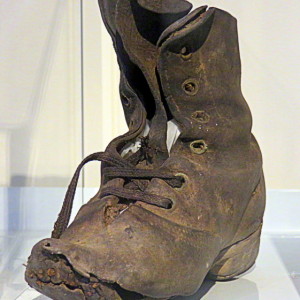Soleful
A few of us went along for a visit to the small but delightful museum in Narberth, a town about 20 miles away. (We're seeking advice on setting up a local heritage centre which isn't as ambitious as a full-blown museum.)
I was struck by the shapes in this display of materials for mending and strengthening shoes with replacement leather soles and metal toe and heel caps. These items might have been used by cobblers or sold for use at home - most working class men possessed a hobbing foot for repairing the family's shoes - see here. That way footwear could be kept going year after year and passed down from child to child.
(I couldn't get a very good shot through the glass so I've fiddled with it a little.)
Nearby was a small child's boot (extra), one of several shoes discovered in a chimney. The custom of hiding footware in concealed locations within buildings is both ancient and widespread. Despite many suppositions there is no absolute certainty as to the meaning of the practice which was conveyed as far as Australia. Even in an age of high child mortality it must have been hard to throw away something as personal as a small, worn shoe that had taken on the shape of its owner's foot.


Comments
Sign in or get an account to comment.


